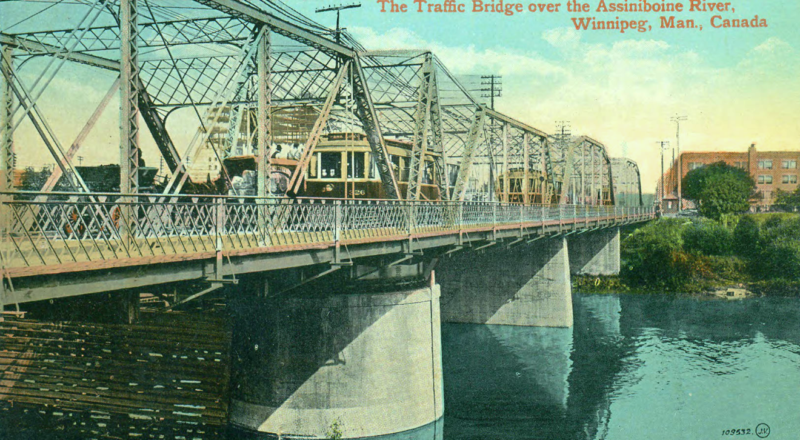
/ Blog
July 4, 2016
Spanning History: Historic Bridges of Winnipeg
Every heritage conservation project has its own challenges, but historically significant bridges tend to be even more difficult to conserve than buildings. A building can often be redeveloped for a new use while preserving its historical character defining elements, but it is often much harder to adaptively reuse a bridge for a number of reasons.
If a bridge was only built to accommodate one lane of traffic in each direction, it is not possible to make it accommodate more traffic without major construction, basically rebuilding the entire bridge. If a bridge was not originally made to carry pedestrians, trying to make space for pedestrian traffic over a bridge is often unrealistic and would not meet modern safety requirements.
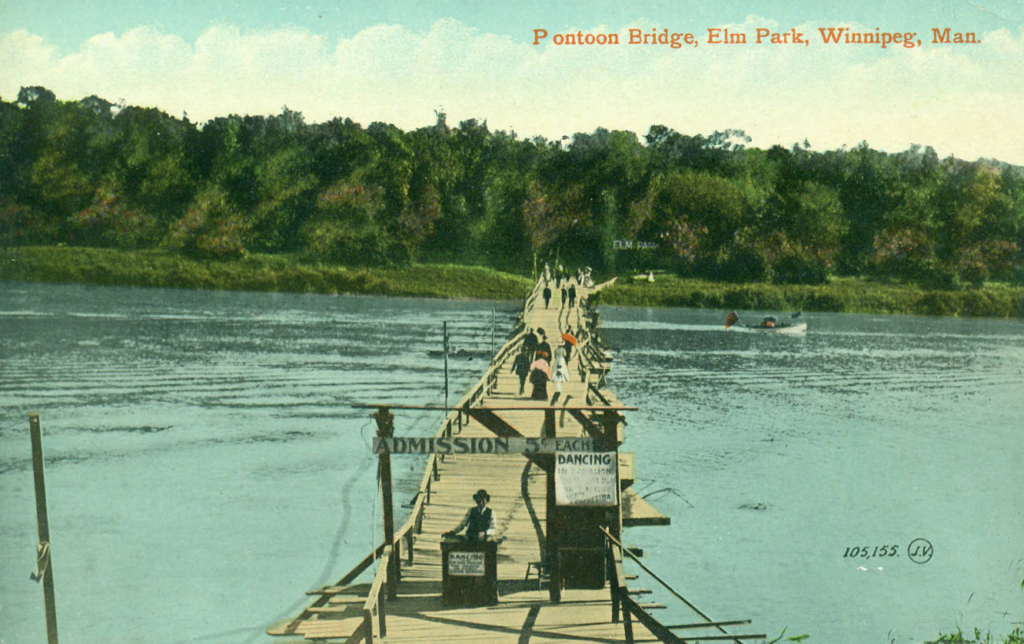
People crossing the pontoon bridge over the Red River into Elm Park. A sign at the near side of the bridge reads, “Admission 5¢ Each.” Other signs read, “Dancing [illegible] Orchestra.” A man stands ready to accept admission payment. A boat has just passed under the bridge.
Source: The Rob McInnes Postcard Collection (Winnipeg Public Library)
Railway bridges are even more difficult, because they fall under federal jurisdiction, meaning they cannot be designated as municipal or provincial historically significant sites.

Train Bridge over the Assiniboine River which is now the Historical Train Bridge at The Forks.
Source: The Rob McInnes Postcard Collection (Winnipeg Public Library)
In the late 1990s, a United States Department of Transportation report stated that approximately 40% of bridges in the United States were structurally deficient and functionally obsolete. That number was approximately the same for Canada. New American studies in 2013 showed that the percentage of obsolete bridges in the U.S. has improved. Only about 10% of bridges are deficient. In Canada however, the percentage of obsolete bridges was still about 30% in 2012.
The cornerstone for Winnipeg’s first permanent traffic bridge, the Louise Bridge, was laid on August 9, 1880. After the ceremony a group of people stole a large amount of liquor intended for city councillors, becoming drunken and disorderly in the streets. The rough start foreshadowed a forthcoming property battle over the east approach, but despite this the bridge was completed and opened in 1881.
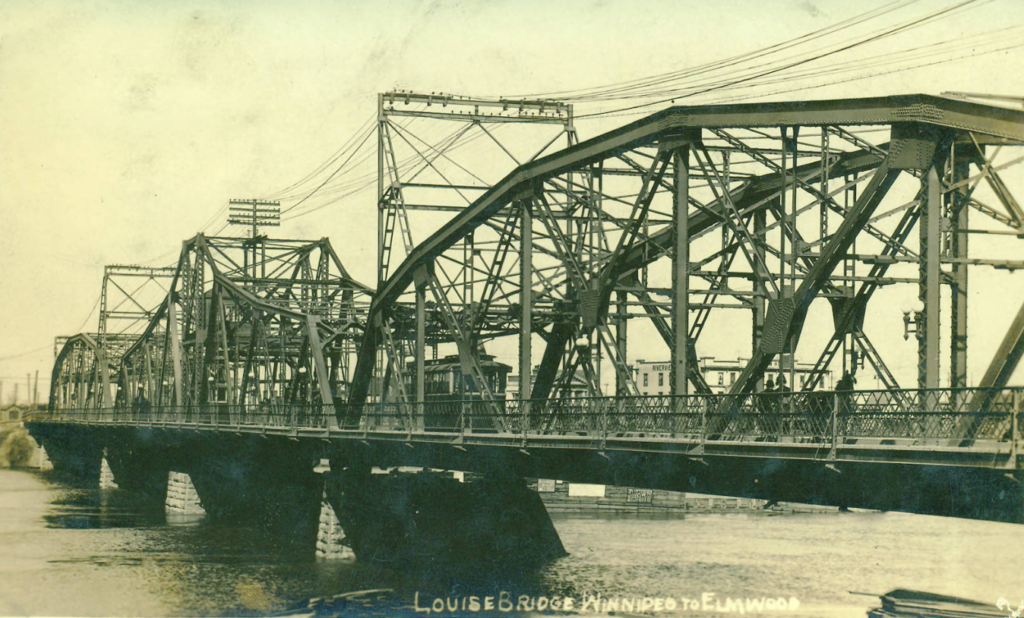
A streetcar and pedestrians cross the Louise Bridge in the early 20th century.
Source: The Rob McInnes Postcard Collection (Winnipeg Public Library)
One of the next bridges constructed in Winnipeg did not even last a week. The Broadway Bridge was built to connect Winnipeg to Provencher Boulevard in St. Boniface. The bridge had only been open four days when it collapsed. Ice jams raised the water levels, and ice flows smashed into the bridge’s piers higher than they had been built to maintain. Luckily, everyone on the bridge managed to make it to safely to shore before the bridge collapsed.
The oldest surviving bridge in Winnipeg is the Redwood Bridge. It was built in 1907-1908. It was built with 700 tonnes of reinforced steel, and had a mid-river swing span. It has had a few upgrades over the years and the swing span is no longer used, but this bridge is still going strong.
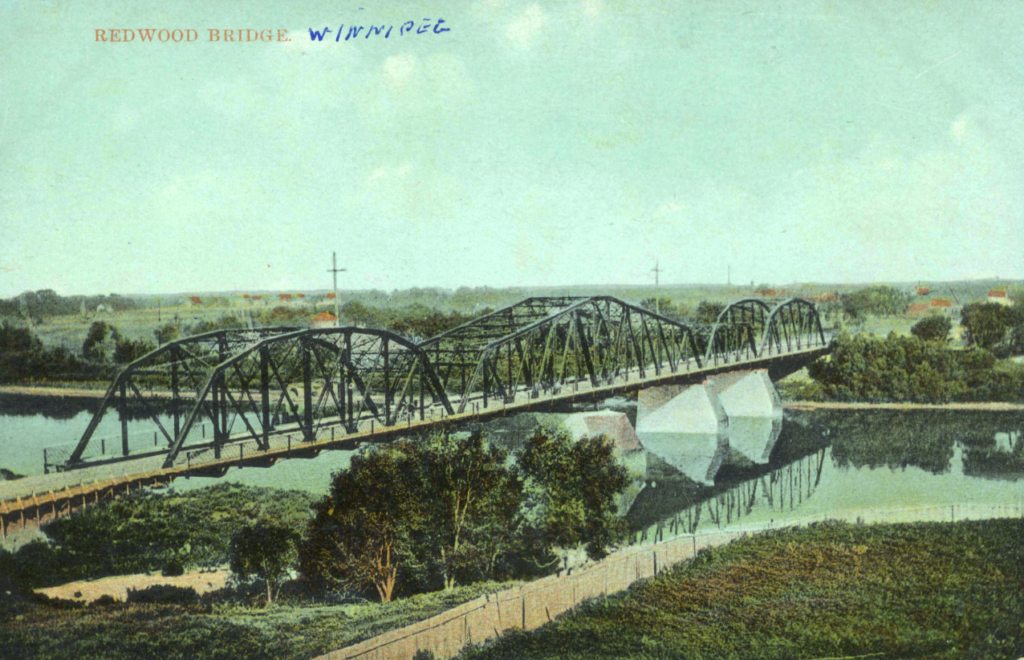
The Redwood Bridge looking east over the Red River sometime after 1908.
Source: The Rob McInnes Postcard Collection (Winnipeg Public Library)
The eighth bridge in Winnipeg was the Arlington Bridge. Built in 1912, it crossed from Brown Street to Brant Street over the huge CP rail yards. Sadly some people have been saying the Arlington Bridge needs to come down almost since the day it was built. And now, that will finally be happening. The City of Winnipeg has scheduled the Arlington Bridge to be demolished by 2020. City councillors throughout the years have been saying the bridge had reached the end of its lifespan.
Alderman Achibald A. McArthur was the main advocate for a bridge in the location of Brown Street and Brant Street, (later renamed Arlington Street after the bridge connected the two streets) but many people disagreed with him. They said they should repair the Slaw Rebchuk Bridge (Salter Street Bridge) instead, because a bridge crossing at Brown and Brant Street was too far out of the way. Some said they had bigger priorities and should not be focusing on a bridge at all. Although McArthur did not give up. As a city councillor and later a member of the city’s Board of Control, he used his position to make sure the project never got forgotten as the years went by.
You may have heard the local legend that the Arlington Bridge was originally not supposed to come to Winnipeg. The story goes that the Cleveland Iron Works had finished a bridge that was supposed to cross the Blue Nile River in Sudan. The contract fell through however, and the bridge never reached Africa. The Cleveland Ironworks submitted their bridge when the City of Winnipeg put out a request for a design. Since the bridge was already constructed they offered it for a significantly reduced cost, so they could get rid of it.
The city bought the already-constructed bridge that was supposed to span the Nile, and it became the Arlington Bridge, but there were were no celebrations when the bridge opened. There was no ribbon cutting, no stolen liquor, no drunken disorderly party. There was nothing at all except Alderman A. A. McArthur, who went alone to see the fruit of his long labour.
One of the main selling points of building the Arlington Bridge was to extend streetcar service. Streetcars could not go through the rail yards, and this made things very inconvenient for people needing to get from one side to the other. The Slaw Rebchuk Bridge was far too old and in poor condition to support streetcars. The new Arlington Bridge would allow streetcars to cross over the rail yards, and it would be a big improvement for people who relied public transportation. No streetcars ever ran over the Arlington Bridge and the city fought with the Winnipeg Electrical Company for years, but the company insisted it would be suicide to try to take a streetcar over. The streetcar rails that had been installed on the bridge were ripped up in the 1920s without ever being used.
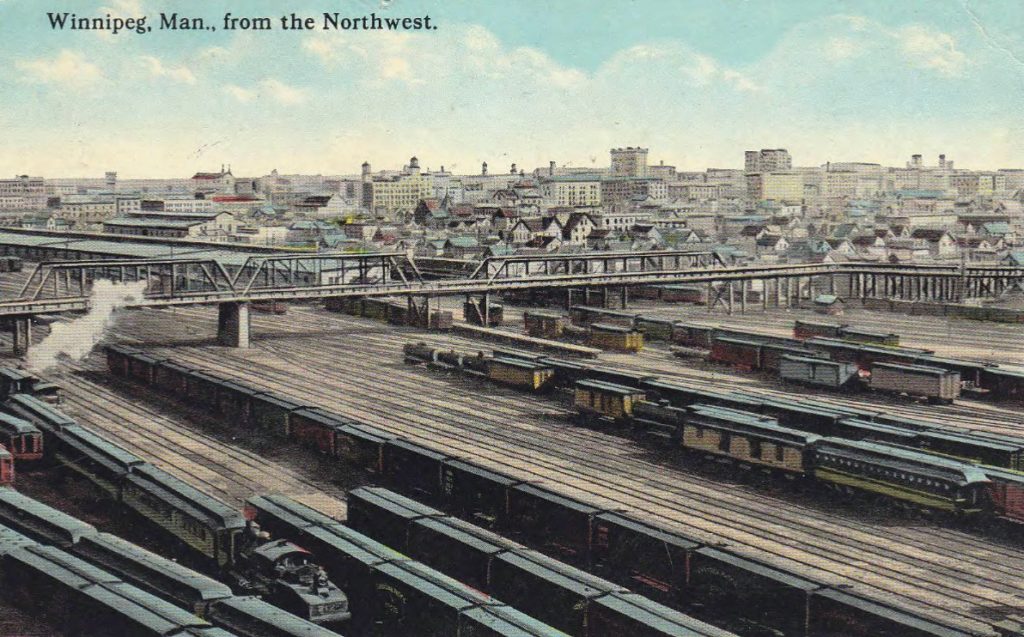
A bird’s-eye view looking southeast toward downtown Winnipeg over the Canadian Pacific Railway yards. Many railroad cars and a few train engines are on several tracks in the foreground. The Slaw Rebchuk Bridge is near centre, and a great number of houses and city buildings stretch into the distance. The twin spires of the St. Boniface Cathedral are visible on the horizon toward the left. From 1904-1914.
Source: Martin Berman Postcard Collection (Winnipeg Public Library)
After the Streetcars rails were ripped up, the bridge needed major repairs in the 1930s. Then it needed to be repaired three times in the 1940s and one of those times it was repaired was for erosion of the iron on the bottom of the bridge. The acidic smoke from trains passing below it was eroding the iron on the bottom of the bridge. The bridge was unable to handle the acidic smoke because it was likely built to go over water, not a train yard, which supports the Nile theory.
The bridge was repaired again in the 1960s, 70s, 80s, 90s, and early 2000s. It was closed completely on multiple occasions. It is now one of the three oldest bridges remaining in the city, but it looks like it may be time for this centenarian to be laid to rest.
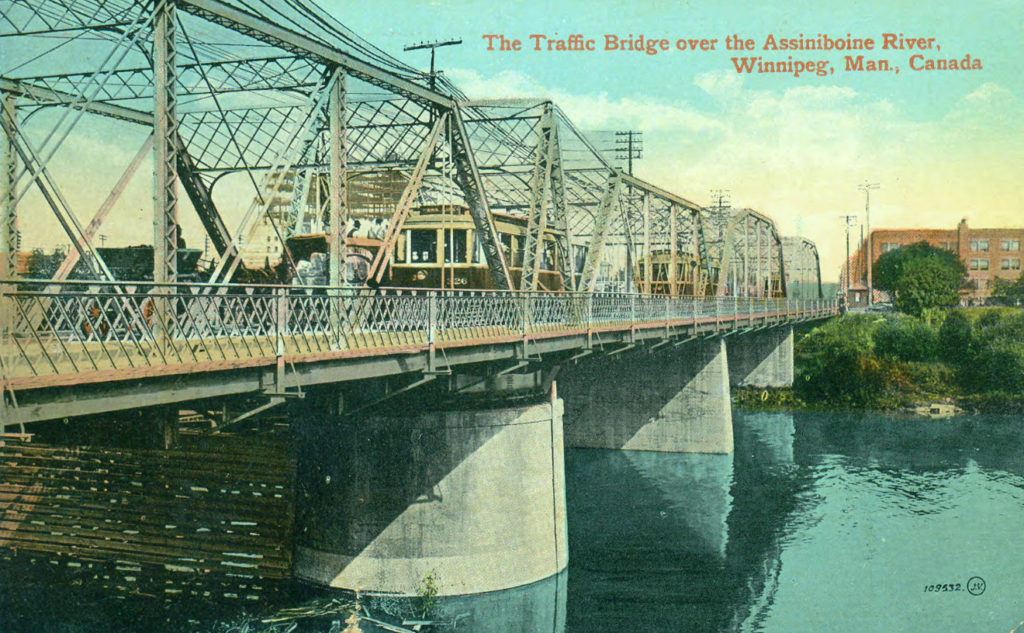
Streetcars and horse drawn wagons crossing the Main Street Bridge, looking North, showing Hudson’s Bay House, now the North West Company. The Fort Garry Hotel construction is not yet completed on the left. From 1911-1913.
Source: Martin Berman Postcard Collection (Winnipeg Public Library)
THANK YOU TO THE SPONSOR OF THIS BLOG POST:

Written by Heritage Winnipeg.
SOURCES:
Bryan Scott - Arlington Bridge
Chronology of Major Bride Construction in Winnipeg
Manitoba Historical Society - Archibald A. McArthur
PastForward - Louise Bridge Winnipeg to Elmwood
PastForward - Pontoon Bridge, Elm Park. Winnipeg, Man.
PastForward - The Canadian Northern Bridge over the Assiniboine River
PastForward - The Traffic Bridge over the Assiniboine River, Winnipeg, Man., Canada
Pastforward - Winnipeg, Man., from the Northwest
West End Dumplings - A history of the Arlington Street Bridge - Part 1
West End Dumplings - A history of the Arlington Street Bridge - Part 3
Winnipeg Free Press - Winnipeg 100





